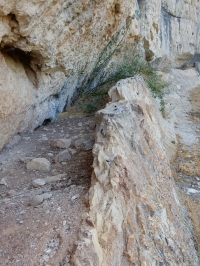| How to visit :
|
The excavation site Uxama Argaela is located just SW of El Burgo de Osma, along the N122 and well signposted. The admission is permanent and free.
The cisterns are only open during specific hours, see the second website above.
- The 133m long Ucero tunnel - part of the Northern aqueduct - can be reached using the main road from Ucero to Nafria (P-5119). At the right / north side
of the road - 250 m after you passed the (first) bridge - there is a small, wooden signpost (which easily can be missed). At this south entrance of the tunnel
just 50 m from the road, there is an information panel. The tunnel is permanent open (September 2016), and the admission is free.
Coordinates: 41 42 46.72N 03 03 13.14W
- At the NW foot of the Uxama hill is a passable part of the Northern aqueduct tunnel, 250m north of the Uxama exit, along the N122; at the east side
of the road is small parking lot plus an information panel.
- Remains of the Eastern aqueduct can be easily found along the SO-160 south of El Burgo de Osma, direction Gormaz. After 1 km the road crosses the
Ucero river and park your car here. A short piece of the channel floor is cut in the rock surface east of the road. A longer part can be found 750 m north
of the bridge, 1 m above the level of the cycle path, cut into the rising rocks.
|

